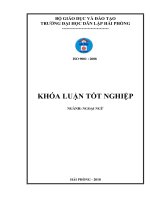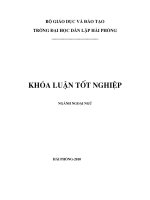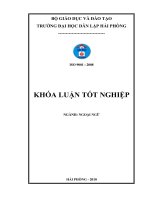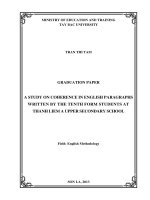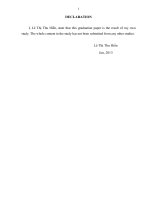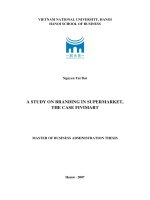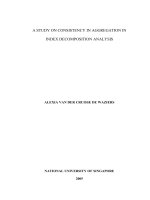A study on consistency in aggregation in index decomposition analysis
Bạn đang xem bản rút gọn của tài liệu. Xem và tải ngay bản đầy đủ của tài liệu tại đây (890.83 KB, 175 trang )
A STUDY ON CONSISTENCY IN AGGREGATION IN
INDEX DECOMPOSITION ANALYSIS
ALEXIA VAN DER CRUISSE DE WAZIERS
NATIONAL UNIVERSITY OF SINGAPORE
2005
A STUDY ON CONSISTENCY IN AGGREGATION IN
INDEX DECOMPOSITION ANALYSIS
ALEXIA VAN DER CRUISSE DE WAZIERS
A THESIS SUBMITTED
FOR THE DEGREE OF MASTER OF ENGINEERING
DEPARTMENT OF INDUSTRIAL AND SYSTEMS ENGINEERING
NATIONAL UNIVERSITY OF SINGAPORE
2005
Acknowledgements
-I-
ACKNOWLEDGEMENTS
I would like to thank my supervisors Professor Ang Beng Wah and Associate
Professor Tan Kay Chuan for their guidance and support throughout this research.
I would also like to thank all the members of the ISE Department, especially my
laboratory mates, who have made my experience in Singapore unforgettable.
Finally, I am grateful to the National University of Singapore, whose financial
support has been essential to the completion of this study.
Table of Contents
-II-
T
ABLE OF CONTENTS
ACKNOWLEDGEMENTS I
TABLE OF CONTENTS II
SUMMARY VI
NOMENCLATURE VIII
LIST OF TABLES IX
LIST OF FIGURES XI
CHAPTER 1 INTRODUCTION 1
1.1 Index Decomposition Analysis 1
1.2 Research objectives 3
1.3 Thesis structure 4
CHAPTER 2 INDEX DECOMPOSITION ANALYSIS METHODS 7
2.1 The decomposition approach 7
2.1.1 The aggregate indicator 8
2.1.2 Additive approach to IDA 9
2.1.3 Multiplicative approach 10
2.2 Methods linked to the Laspeyres index 11
2.2.1 Laspeyres and Paasche indexes 11
2.2.2 Marshall-Edgeworth index 13
2.2.3 Fisher Ideal index 13
2.3 The Divisia index methods 15
2.3.1 The principles 15
2.3.2 AMDI (Törnqvist index) 18
2.3.3 LMDI I (Vartia I) 18
2.3.4 LMDI II (Sato-Vartia) 19
2.4 Other methods 20
Table of Contents
-III-
2.4.1 Stuvel index 20
2.4.2 Mean Rate of Change Index 21
2.5 Summary of all the methods presented 21
2.6 The methodological issues: the test approach 24
2.7 Conclusion 27
CHAPTER 3 THEORY OF CONSISTENCY IN AGGREGATION 29
3.1 Disaggregation 30
3.1.1 Definition 30
3.1.2 Importance of disaggregation in decomposition studies 30
3.1.3 Limits of disaggregation in decomposition studies 32
3.2 The price and quantity index 33
3.3 Consistency in aggregation 34
3.3.1 Definition: The aggregation 34
3.3.2 Definition: Consistency in aggregation 35
3.4 Approximate consistency in aggregation 36
3.4.1 The functional form of the aggregator 37
3.4.2 Numerical approximation 39
3.4.3 The residual term 40
3.5 Three types of consistency in aggregation 41
3.6 Advantages of the consistency in aggregation 44
3.7 Conclusion 46
CHAPTER 4 CONSISTENCY IN AGGREGATION AND INDEX
DECOMPOSITION ANALYSIS 47
4.1 Consistency in aggregation for IDA 48
4.1.1 The disaggregation for IDA 48
4.1.2 Advantages of consistency in aggregation in IDA 49
4.1.3 Additive and multiplicative approaches 51
4.2 Methodology for the study of consistency in aggregation 52
4.3 The Additive methods 53
4.3.1 Proof of consistency in aggregation for the methods linked to the Laspeyres index 53
4.3.2 Consistency in aggregation for AMDI, LMDI I and LMDI II 56
4.3.3 Consistency in aggregation for the Mean Rate of Change Index 57
4.4 The multiplicative methods 58
4.4.1 Methods linked to the Laspeyres index 59
4.4.2 The methods linked to the Divisia Index method 62
4.5 Conclusion 65
CHAPTER 5 CASE STUDY, THE CANADIAN INDUSTRIAL SECTOR 68
5.1 The Data 69
Table of Contents
-IV-
5.2 Methodology 70
5.2.1 Decomposition formula 70
5.2.2 Contributing factors studied 71
5.2.3 Study of the consistency in aggregation 73
5.3 Additive approach 75
5.3.1 Results of the decomposition 75
5.3.2 Consistency in aggregation of the additive methods 76
5.4 Multiplicative approach 77
5.4.1 Results of the decomposition study 77
5.4.2 Consistency in aggregation of the multiplicative methods 78
5.5 Conclusion 79
CHAPTER 6 CONSISTENCY IN AGGREGATION, THE CASE OF
PARTIAL FULFILLMENT 82
6.1 Multi-level indexes 83
6.1.1 The multi-level indexes 83
6.1.2 The problem found in the literature 84
6.1.3 Other decomposition formulae affected 86
6.2 The partial consistency in aggregation for multiplicative methods 89
6.2.1 LMDI I 89
6.2.2 Laspeyres index 93
6.3 The issue of partial fulfillment for consistent additive methods 94
6.3.1 Divisia index methods 95
6.3.2 Methods linked to the Laspeyres index 96
6.3.3 The other methods 97
6.4 Case study 98
6.4.1 Data and methodology 98
6.4.2 LMDI I multiplicative 100
6.4.3 The additive Divisia index methods 101
6.4.4 The Laspeyres index 102
6.4.5 MRCI 103
6.5 Conclusion 104
CHAPTER 7 CASE STUDY, ENERGY CONSUMPTION IN CANADA 106
7.1 The measurement of energy efficiency 107
7.1.1 The physical indicators 107
7.1.2 The current practice in energy efficiency monitoring 108
7.2 The use of physical indicators 111
7.2.1 Aggregating the physical indicators 111
7.2.2 The decomposition formula and the physical indicators 113
7.3 Methodology 115
7.3.1 Data 115
7.3.2 Methodology 115
7.3.3 The decomposition applied to the end-use sectors 116
7.4 Results 124
7.4.1 Results at the sector level 124
Table of Contents
-V-
7.4.2 Results for the entire country 129
7.5 The advantages of the total consistency in aggregation 131
7.6 Conclusion 132
CHAPTER 8 CONCLUSION 134
REFERENCES 138
APPENDIX A
SECTOR CLASSIFICATION FOR THE CANADIAN INDUSTRY 142
APPENDIX B DATA FOR THE DECOMPOSITION OF THE INDUSTRIAL ENERGY
CONSUMPTION IN CANADA 144
APPENDIX C RESULTS FOR THE DECOMPOSITION OF THE INDUSTRIAL ENERGY
CONSUMPTION IN CANADA BETWEEN 1990 AND 2000 146
APPENDIX D DATA FOR THE STUDY OF THE CHANGES IN ENERGY CONSUMPTION
IN CANADA BETWEEN 1996 AND 2001 151
APPENDIX E RESULTS OF THE DECOMPOSITION OF THE CHANGES IN ENERGY
CONSUMPTION 159
Summary
-VI-
S
UMMARY
Decomposition methodology is a statistical technique used to analyze a set of
data at the aggregate level. It aims to establish the relative contributions of a set of
underlying factors to the changes in an aggregate, such as energy consumption in a
country. To conduct decomposition studies, researchers have developed numerous
methods based on the index number theory.
Researchers are currently seeking a common agreement as to which method is
best among those found in the literature. This agreement should be found through the
study of the theoretical properties established by a set of predefined tests. Among
these tests, the most important are the factor-reversal test, the time reversal test, the
proportionality test, and the consistency in aggregation test. This study focuses on
only the last test, since it has not yet been thoroughly studied in Index Decomposition
Analysis. Hence, the main contribution of this study is to redefine the consistency in
aggregation in Index Decomposition Analysis (IDA) and study this attribute for the
main IDA methods.
Vartia’s definition of the consistency in aggregation (Balk, 1996) is
restrictive. Researchers consider three types of approximations: the functional form of
the aggregator function, the residual term, and numerical approximations. We define
three degrees of consistency in aggregation to include more methods: type A, exact
Summary
-VII-
consistency in aggregation; type B, partial consistency in aggregation; and type C,
approximate numerical consistency in aggregation. However, in some situations
consistency in aggregation is only partially fulfilled, even with decomposition
methods that are consistent with type A. After studying this issue we find that the
Log-Mean Divisia Index I (LMDI I) is the best method for considering consistency in
aggregation.
Finally, through a case study we examine consistency in aggregation with the
use of physical indicators in energy-consumption monitoring.
List of Abbreviations
-VIII-
N
OMENCLATURE
AMDI Arithmetic Mean Divisia Index
APEC Asia Pacific Economic Cooperation
GDP Gross Domestic Product
GJ Giga Joules
GO Gross Output
IDA Index Decomposition Analysis
IDM Index Decomposition Methods
IEA International Energy Agency
LMDI Log-Mean Divisia Index
MJ Mega Joules
MRCI Mean Rate of Change Index
NAICS North American Industry Classification System
OECD Organization for Economic Co-operation and Development
PJ Peta Joules
SIC Standard Industrial Classification
TJ Tera Joules
List of Tables
-IX-
LIST OF TABLES
2-1 Presentation of the IDA additive methods
2-2 Presentation of the IDA multiplicative methods
2-3 Formulae for the IDA additive methods
2-4 Formulae for the IDA multiplicative methods
2-5 The results of the test approach
4-1 The consistency in aggregation for the IDA methods
4-2 The aggregator functions
5-1 Main sectors of the Canadian industrial sector
5-2 Results of the decomposition study for the additive methods
5-3 Summary of the multiplicative results, The Canadian Industry
5-4 Complete results of the consitency in aggregation of the IDA methods
6-1 Example of multi-level index, Share of GDP
6-2 Energy consumption: Chinese Industry 1985-1990
6-3 Results for the decomposition study: LMDI I multiplicative method
6-4 Group results for the two types of two-step procedures: LMDI I multiplicative
6-5 Results for the two types of decomposition: LMDI
6-6 Results for the two types of decomposition: AMDI
6-7 Results for the two types of decomposition: Laspeyres Index, Paasche and Marshall-
Edgeworth
6-8 Results for the two types of decomposition: MRCI
7-1 Measure of energy Intensity Indicators: Canada
7-2 Measure of energy Intensity Indicators: IEA
A. 1 Sector classification for the Canadian industry based on NAICS
B. 1 Data for the decomposition of the industrial energy consumption in Canada between 1990
and 2000
C. 1 Results for the decomposition of the changes in energy consumption of the Canadian
industry: Laspeyres, Fisher Ideal, Paasche and Marshall-Edgeworth
C. 2 Results for the decomposition of the changes in energy consumption of the Canadian
industry: MRCI, AMDI , LMDI I, LMDI II
C. 3 Results of the multiplicative decomposition: LMDI II, LMDI I and AMDI
C. 4 Results of the multiplicative decomposition: Laspeyres, Paasche and Marshall-Edgeworth
D. 1 Data for the residential sector
D. 2 Data for the passenger transport sector
D. 3 Data for the freight transport sector
List of Tables
-X-
D. 4 Data for the Non-Manufacturing sector
D. 5 Data for manufacturing sector and the entire industrial sector
D. 6 Data for the institutional sector
D. 7 Data for the commercial sector
D. 8 Data for the agriculture sector
D. 9 Data for the electricity generation sector
E. 1 Results for the industrial sector
E. 2 Results for the other sectors
E. 3 Results for the Canadian energy economy and the main sectors
List of Figures
-XI-
L
IST OF FIGURES
1-1 Structure of the thesis
3-1 Disaggregation of the economy
3-2 Two dimensional disaggregation of the data set
3-3 Different branchings of the disaggregation of the economy
3-4 The aggregation process
4-1 Aggregation structure.
5-1 Disaggregation of the Canadian Industrial sector
6-1 The disaggregation of an economy
6-2 Structure of the economy
7-1 Residential Sector Floor Space Services
7-2 Residential sector Household Services
7-3 Commercial Sector
7-4 The correlation between the energy changes and the profitability changes in the
Canadian industry between 1996 and 2001
7-5 Industrial Sector
7-6 Changes in Energy consumption between 1996 and 2001: Residential sector
7-7 Changes in energy consumption between 1996 and 2001: Commercial sector
7-8 The changes in energy consumption of the Industrial sector between 1996 and 2001
7-9 Changes in energy consumption between 1996 and 2001: Transport sector
7-10 Changes in energy consumption between 1996 and 2001: Agriculture sector
7-11 Changes in energy consumption between 1996 and 2001: Electricity Generation sector
7-12 Changes in energy consumption between 1996 and 2001: economy wide
7-13 The impact of energy intensity on energy consumption
Chapter 1 Introduction
-1-
CHAPTER 1 INTRODUCTION
1.1 Index Decomposition Analysis
Index Decomposition Analysis (IDA) methods aim at understanding historical
changes in economic, environmental, and other socio-economic indicators. The first
step of an IDA is to define a meaningful aggregate indicator and a set of pre-defined
factors of interest on which the aggregate indicator is decomposed.
The methodology for IDA has been derived from the index number theory
developed in the field of economics to study how quantity and price levels contribute
to changes in aggregate commodity consumption. Here, the aggregate indicator is
commodity consumption, and the pre-defined factors are the quantity index and the
price index. However, the development of IDA methods has been driven by
decomposition problems in the field of energy after the 1973 world energy crisis.
Ang (2003) has identified five main application areas of IDA:
● Material flow and dematerialization
Chapter 1: Introduction
-2-
These studies aim at analyzing the development of material use in an
economic structure. Of interest is a wide range of metallic and non-metallic minerals,
coal, oil, and natural gas, which are treated as material rather than energy sources.
● Cross-country comparison
These studies aim at quantifying the factors contributing to an aggregate index
between two countries or two regions.
● Energy-related gas emissions
Focusing on energy-related carbon dioxide emissions and decomposition, these
studies usually analyze the impact of energy efficiency changes, structural changes,
and other factors such as the fuel mix effect and the fuel gas emissions coefficient
changes. The increasing number of such studies reflects growing worldwide
environmental concerns (see Ang and Zhang, 2000).
● National energy efficiency trend monitoring
This type of study seeks to measure progress towards national energy
efficiency targets. Energy efficiency changes are usually estimated through the
computation of its inverse energy intensity, which is the ratio between the energy
consumption of a sector and the industrial output of the same sector.
● Energy demand and supply
This type of study involves the analysis of industrial energy consumption,
national energy consumption, or the analysis of problems related to the energy supply
sector, such as the impact of fuel consumption in the electricity generation sector.
Chapter 1: Introduction
-3-
Usually these studies aim at disentangling the impacts of structural changes and
energy efficiency changes.
We focus our study on the energy demand and supply area because of the
increasing worldwide interest in this type of IDA studies and the recent technical
development in index decomposition methodology in this application area one of
which being the monitoring of the energy efficiency changes through the same
framework.
1.2 Research objectives
IDA has been widely adopted by researchers for studying the impact of a set
of pre-defined factors on an aggregate of the five main areas previously presented.
However, no consensus exists among researchers and analysts on the best
decomposition method. Many studies have sought to create this consensus by
comparing the methods rigorously and comprehensively; among these studies are
those conducted by Howarth et al. (1991), Ang and Lee (1994), Albrecht et al.
(2002), Phylipsen et al. (1997), Ang and Liu (2001,2003), Nanduri et al. (2002), and
Granel (2003). Most do not consider consistency in aggregation
1
at all, or they
consider it for only one method (see Ang and Liu, 2001; Nanduri, 2002). Yet this
attribute has been thoroughly studied in index number theory and should not be
neglected in comparing IDA methods.
1
This attribute means that the analyst obtains the same results when he carries the study in a single-step or a multi-steps
procedure.
Chapter 1: Introduction
-4-
The objective of this research is to study consistency in aggregation for the
IDA methods. We propose three steps to conduct this study. First, we will review the
consistency in aggregation studies that have been conducted in the index number
theory. This analysis will enable us to establish a definition of consistency in
aggregation. We will then conduct a study of consistency in aggregation on a
selection of IDA methods based on this definition and, finally, validate it through a
case study with features that will complement and highlight the outcomes of the
results we obtain theoretically.
1.3 Thesis structure
This thesis is comprised of eight chapters. Figure 1.1 represents the
framework of the thesis, the content of the chapters, and the relationship between
different chapters.
Chapter 2 is devoted to a review of the literature related to the decomposition
methods and the concepts of IDA. We present the different methods, organize them in
an optimal manner for the study of consistency in aggregation i.e. we separate
additive and multiplicative methods and within both categories we group the methods
according to their functional forms, and review the attributes that have already been
studied for each method.
Chapter 3 reviews the different definitions of consistency in aggregation in the
index number theory and approximations to the definition. We then use these
Chapter 1: Introduction
-5-
definitions and approximations as a basis for defining three degrees of consistency in
aggregation.
Chapter 4 focuses on consistency in aggregation for the IDA methods. We
first consider the specificity of consistency for IDA methods, and then study
theoretically the consistency of these methods. This chapter analyzes the performance
of each decomposition method with respect to the different degrees of consistency in
aggregation.
Chapter 5 presents a case study that highlights the importance of consistency
in aggregation, through a comparison of all the methods studied in Chapter 3. We
study numerically the extent of inconsistency in aggregation of the methods
previously proven to be theoretically inconsistent and determine whether these
methods can be considered approximately consistent in aggregation from a numerical
point of view.
Chapter 6 presents an aggregation issue, which we call partial fulfillment of
consistency in aggregation, found in the literature. We seek to provide a detailed
study of this issue (i.e. the affected methods, the type of factors affected, and the
decomposition formula) and solutions to this problem.
Chapter 7 presents the physical indicators for energy efficiency and the
aggregation issues posed by the use of such factors. We then conduct a case study
highlighting the advantages of total consistency in aggregation based on the findings
in this research.
Chapter 1: Introduction
-6-
Finally, Chapter 8 concludes this dissertation by succinctly recalling the key
findings in the research and considering the main areas for future research.
Figure 1-1: Structure of the thesis
Chapter 1
Introduction
Chapter 2
Index Decomposition
Analysis methods
Chapter 3
Theory of consistency
in aggregation
Chapter 4
Consistency in
aggregation and IDA
Chapter 5
Case study,
The Canadian industrial
sector
Chapter 6
Consistency in aggregation,
the case of partial
fulfillment
Chapter 7
Case study, the energy
consumption in Canada
Chapter 8
Conclusion
Chapter 2 Index Decomposition Analysis Methods
-7-
CHAPTER 2 INDEX DECOMPOSITION ANALYSIS
METHODS
A wide range of methodologies is available to perform an IDA. Determining
the most suitable method to conduct the study is crucial. The aim of this chapter is
first to present the additive and multiplicative approaches to IDA, and then to review
the methods available and classify them. The Laspeyres linked methods use weights
based on the value in the base year while the Divisia index methods use a logarithmic
ratio to weigh the aggregate factor. Other methods include the Mean-Rate-of-Change
Index (MRCI) and the Stuvel index. We present the attributes that have already been
studied for these methods and summarize the decomposition formulae for both the
additive and the multiplicative approaches.
2.1 The decomposition approach
The decomposition of an aggregate can be conducted either multiplicatively or
additively. Comparing the two approaches, Ang and Choi (2003) argued that each
approach has its own merits: the multiplicative approach has the advantage of giving
concise results, whereas the additive approach provides easily understood
Chapter 2 Index Decomposition Analysis Methods
-8-
information. Ang and Choi also stress that the choice depends on the aggregate
indicator studied. Therefore, we study both approaches for each method.
We first define an aggregate indicator; then we present the basic additive
approach and the basic multiplicative approach.
2.1.1 The aggregate indicator
An aggregate indicator is defined as an indicator at an aggregate level. This
aggregate level incorporates many indivisible processes and disaggregated data at the
lower levels of disaggregation (see Chapter 3).
Mathematically, we assume that X is an aggregate index and decomposed in r
causal factors x:
iri
i
i
i
i
xxxXX
,,2,1
∑
∑
==
and
iriii
xxxX
,,2,1
= , where the subscript
i denotes an attribute such as the sector or sub-sector. For example, the energy
consumption in a country can be decomposed as:
YSIY
Y
Y
Y
E
EE
i
i
i
i
i
i
i
i
i
∑∑∑
=== (2.1)
where
E
i
is the energy consumption of sector i, E the energy consumption of the
highest level of aggregation, and
Y
i
the Gross Domestic Product (GDP) of sector i.
Y
Y
S
i
i
= is the share of energy consumption of sector i;
i
i
i
Y
E
I
= is the energy intensity
of sector
i; and Y is the total GDP.
As we will later study the aggregation problem, we introduce two levels in the
formula to present the different decomposition methods. The subscript
j denotes a
Chapter 2 Index Decomposition Analysis Methods
-9-
lower attribute than the subscript
i, such as a sub-sector (if i denotes a sector) or a fuel
type:
ijrij
ij
ij
xxxX
,,2,1
∑∑
= (2.2)
In this formula, x
r,ij
denotes an index such as the one presented in Eq. 2.1, in which
the aggregate X is decomposed. We assume this aggregate X changes between 0 and T
from the quantity
∑∑
=
ji
ijrijij
xxxX
0
,
0
,2
0
,1
0
to
∑
∑
=
ji
T
ijr
T
ij
T
ij
T
xxxX
,,2,1
(2.3)
2.1.2 Additive approach to IDA
The general formula for the additive approach is:
rsdxxx
T
tot
XXXXXXX
r
∆+∆++∆+∆=−=∆
21
0
(2.4)
r
x
X∆ represents the contribution of index x
r
to the changes in the aggregate index,
between 0 and T, in terms of quantity of X. The last factor
rsd
X∆ is the residual term
that represents the difference between the results of the decomposition and the actual
change in the aggregate index. When the method gives a perfect decomposition, the
residual term is null.
Table 2-1 presents the methods for which we will study the additive approach.
Chapter 2 Index Decomposition Analysis Methods
-10-
Table 2-1: Presentation of the IDA additive methods
A
pp
roach Grou
p
Metho
d
Las
p
e
y
res
Paasche
Marshall-Edgeworth
Methods linked to the
Laspeyres index
Fisher Ideal
AMDI
LMDI I
Methods linked to the
Divisia index
LMDI II
Stuvel index
Additive
Other methods
MRCI
2.1.3 Multiplicative approach
For the multiplicative approach the formula takes the following form:
rsdxxx
T
tot
DDDD
X
X
D
r
21
0
== (2.5)
where
i
x
D represents the effect associated with the index x
i
in fraction of D
tot
. If the
method used to conduct the study gives a perfect decomposition, then D
rsd
(the
residual term for the multiplicative approach) is equal to 1.
Table 2-2 presents the methods for which we will study the multiplicative
approach.
Chapter 2 Index Decomposition Analysis Methods
-11-
Table 2-2: Presentation of the IDA multiplicative methods
A
pp
roach Grou
p
Metho
d
Las
p
e
y
res
Paasche
Marshall-Edgeworth
Fisher Ideal
Methods linked to the
Laspeyres index
Fisher Modified
AMDI
LMDI I
Methods linked to the
Divisia index
LMDI II
Stuvel index
Multiplicative
Other methods
MRCI
2.2 Methods linked to the Laspeyres index
The Laspeyres, Paasche, Marshall-Edgeworth and Fisher Ideal indexes have
the advantage of being intuitive. The Laspeyres and Paasche indexes, as superlative
indexes (see Diewert, 1976), can be considered discrete approximations of the
continuous Divisia index. These methods follow the Laspeyres price and quantity
index in economics by isolating one of the variables and considering it as a
perturbation, while leaving other variables at their base-year value.
2.2.1 Laspeyres and Paasche indexes
The Laspeyres index method was suggested by Park (1992), who proposed
that the obtained results can be more easily interpreted. However, this method has
been widely criticized by researchers because it leaves a large value for the residual
term (Ang et al., 1998). The multiplicative formula for this method is:
Chapter 2 Index Decomposition Analysis Methods
-12-
()
0
0
,,
0
,2
0
,1
X
xxxx
D
ij
ijr
T
ijzijij
Laspeyres
x
z
∑
∑
= (2.6)
And the corresponding additive formula is:
(
)
00
,,
0
,2
0
,1
XxxxxX
ij
ijr
T
ijzijij
Laspeyres
x
z
−=∆
∑∑
(2.7)
where for both approaches
(
)
∑
∑
=
ij
ijrijij
xxxX
0
,
0
,2
0
,1
0
and x
z
refers to one of the factors of the decomposition of the aggregate index X such
as an efficiency or growth factor.
Some researchers prefer to express the results for the additive decomposition
in percentage rather than in physical unit (see Schipper et al., 1997 and Farla et al.,
1998). The formula then becomes:
()
()
11
0
0
,,
0
,2
0
,1
0
%
−=−=
∆
=∆
∑
∑
Laspeyres
x
ij
ijr
T
ijzijijLaspeyres
x
Laspeyres
x
z
z
z
D
X
xxxx
X
X
X (2.8)
The difference between the Paasche index and the Laspeyres index is that, for
the Paasche index, the weights are based on the current value (in year T) instead of
the past value (year 0). The multiplicative formula is:
()
T
ij
T
ijrijz
T
ij
T
ij
Paasche
x
X
xxxx
D
z
∑∑
=
,
0
,,2,1
(2.9)
and the corresponding additive formula is:
(
)
T
ij
T
ijrijz
T
ij
T
ij
Paasche
x
XxxxxX
z
−=∆
∑
∑
,
0
,,2,1
(2.10)
where
(
)
∑∑
=
ij
T
ijr
T
ij
T
ij
T
xxxX
,,2,1
